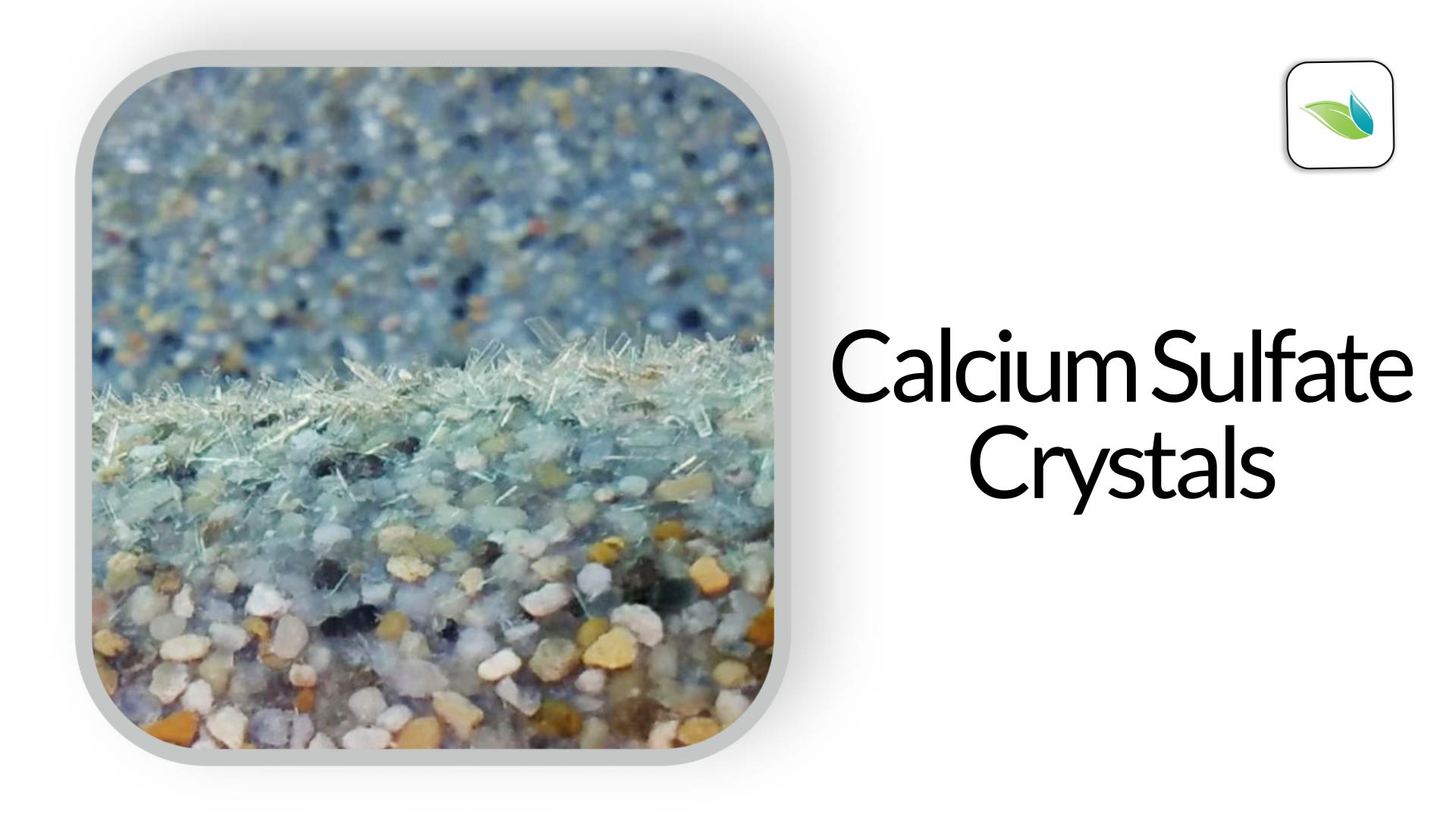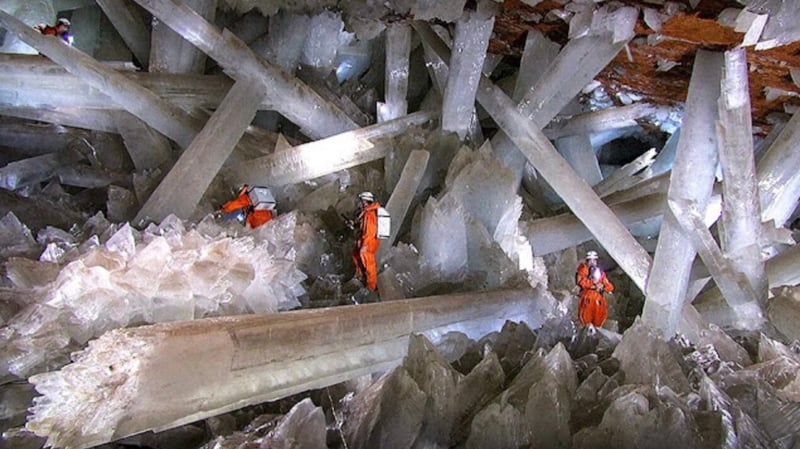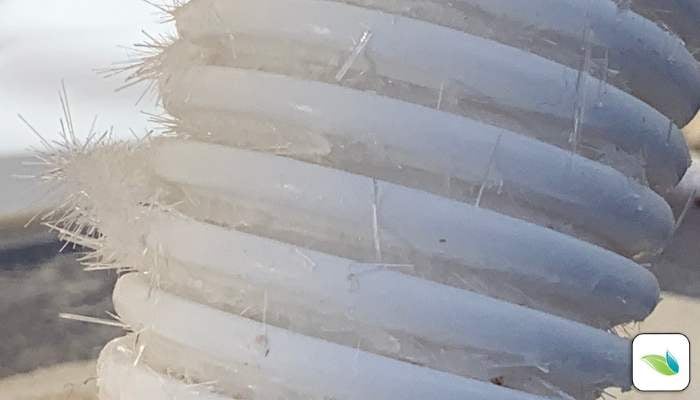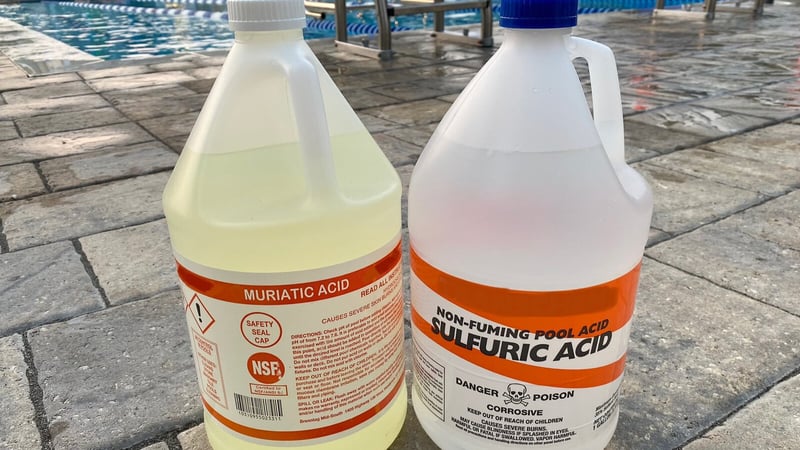Understanding Calcium Sulfate Scale Crystals

Do you have sharp crystals in your swimming pool? Depending on your circumstances, they may not be calcium carbonate (aka calcite). They could be calcium sulfate crystals. This article will explain what calcium sulfate is, how and why it forms crystals in swimming pools, and how to prevent it.
Covered in this article:
- What is calcium sulfate?
- Sulfates in swimming pools
- Calcium sulfate scale
- How to remove calcium sulfate scale crystals from a swimming pool
- How to prevent calcium sulfate scale crystals
- Conclusion


















What is calcium sulfate?
Calcium sulfate (CaSO4) is an insoluble calcium compound that can form sharp crystals on underwater surfaces. It forms as a type of scale in swimming pools as a type of scale, though it is NOT the same as carbonate scale.1 Calcium sulfate forms a crystalline scale as it precipitates out of solution and lands on surfaces. Contrast that with calcite crystals (winter crystals), which grow out of the pool plaster due to aggressive water.2
In an effort to simplify this chemistry, there are three common variations (hydrates) of calcium sulfate. According to the journal Crystal Growth & Design:
The calcium sulfate crystal system is of considerable fundamental and practical interest, consisting of the three hydrates: gypsum (CaSO4·2H2O), bassanite (CaSO4·0.5H2O), and anhydrite (CaSO4).3
From what we can gather from research online, the common form of calcium sulfate scale in swimming pools is calcium sulfate dihydrate, aka gypsum (CaSO4·2H2O). There may be other forms, but as of right now, we do not yet know. We have not tested enough samples to know if there are other forms of calcium sulfate forming scale in pools.
The crystals we find in pools look identical in structure to large gypsum crystals found in caves, like this one in Mexico:
 Giant crystal cave in Naica, Mexico. Photo credit: geologyin.com
Giant crystal cave in Naica, Mexico. Photo credit: geologyin.com
Sulfates in swimming pools
Sulfates are dissolved mineral compounds that contain the element Sulfur. These include calcium sulfate, magnesium sulfate, and sodium sulfate. As water passes through soils that contain sulfates, it dissolves them, which is how sulfates wind up in our drinking water. If you have high levels of sulfates in your drinking water, we recommend filtering them out before consuming the water or putting it in your swimming pool.
As it pertains to swimming pools, sources of sulfates include tap water, but the main sources are pool chemicals you may use. Primarily, we're talking about alternative acids like sulfuric acid and sodium bisulfate (dry acid). Non-chlorine shock (potassium monopersulfate) also contributes if you use it, and so does copper sulfate algaecide.
Sulfates create at least two problems in swimming pools: corrosion and calcium sulfate scale. But there are more. According to the UK's water advisory group PWTAG, sulfates should not exceed 300 mg/L (ppm).4 Here's an excerpt from the PWTAG website on sulfate levels:
Clause 7.3.2.1 General
Ideally the sulphate concentration (SO42-) of water in swimming pools should not exceed 300 mg/L. Where greater concentrations of sulphates cannot be avoided, impermeable adhesives and grouting materials that are not affected by sulphates should be used. High levels of sulphate would otherwise react with and erode materials containing Portland cement (CEM 1). - PWTAG [emphasis added].
300 ppm (or mg/L) is a surprisingly low threshold considering how much sulfate is left behind by sulfuric acid and sodium bisulfate. If you're using these acids regularly, you should plan for regular dilution cycles.
Calcium sulfate scale

Like any other type of scale, the calcium sulfate scale occurs when the water is oversaturated with it. Oversaturation drives the calcium compound out of the solution, and it lands on surfaces.5 Any surface submerged in water is susceptible, not just plaster surfaces. Oddly enough, unlike the calcium carbonate scale, which can be driven out of solution by high pH, calcium sulfate tends to scale at a lower pH.
The key difference between the calcium carbonate scale and calcium sulfate scale is that water craves equilibrium with calcium carbonate (hence why the LSI is so critically important), but water does not need saturation of calcium sulfate. In fact, we don't want any calcium sulfate in our water if we can help it.
As mentioned in the first section of this article, the calcium sulfate scale forms sharp crystals that look almost like glass needles. As they grow, they become more opaque in color, but they start as translucent crystals that are difficult to see. Depending on the chemistry of the water, calcium sulfate can take over a pool in a short amount of time.
How to remove calcium sulfate scale crystals from a swimming pool
Unfortunately, if you have a calcium sulfate scale, there's not much that you can do chemically to fix the problem. We learned from a retired chemist homeowner who contacted us through the Orenda Help Center that we could soften calcium sulfate (which he referred to as gypsum crystals) with a high pH. He suggested trying sodium hydroxide, which has a pH of over 13.6
In December 2022, we visited Que Hales from onBalance, and shared this idea. Que had sodium hydroxide, and in his office laboratory, he showed within a couple of days that sodium hydroxide did, in fact, soften the calcium sulfate into a gel.
Even with sodium hydroxide, the process takes time, and the material still needs to be cleaned off and removed physically. As of now, we don't see it as much of a time, cost, or labor savings. Most people need to physically grind/sand the crystals off. This is a labor-intensive process, but unfortunately, there is no easy chemical answer. Que himself discovered that boiling muriatic acid did something, but who wants to boil muriatic acid? I know we don't.
The better strategy is to prevent the calcium sulfate scale from happening in the first place.
How to prevent calcium sulfate scale crystals
The key to preventing the oversaturation of calcium sulfate is to limit sulfates in your water, to begin with.7 You can also chelate calcium to prevent it from binding to sulfates that may be in your water. Another thing you can do is avoid overcorrecting your pH with acid because lower pH tends to drive calcium sulfate out of the solution.
Limiting sulfates may be difficult if you have high sulfates in your tap water. Areas like Tucson, AZ, and Las Vegas, NV, seem to have higher levels of sulfates in the tap. Consult your local water treatment authorities and ask for chemistry tests of everything in the tap water. As a public utility, they are required by law to share the results with you if you ask. Be sure to ask for sulfates (and while you're it, ask for other things like combined chlorine, nitrates, metals, etc., because why not know?).
As mentioned earlier in this article, the easiest way to limit sulfates in your pool is to minimize (or avoid) the use of pool chemicals that contain sulfates: sulfuric acid, sodium bisulfate, potassium monopersulfate, copper sulfate algaecide, etc.
If sulfates are unavoidable, dilution or reverse osmosis (RO) filtration may be necessary to reduce sulfate levels. Keep them as low as possible.
Conclusion
For years, we hardly ever heard of calcium sulfate scale crystals. But lately, they seem to have become more common. As water ages–especially in drought-prone areas that cannot dilute water as often–evaporation leads to accumulation. Sulfates accumulate over time, and eventually, there can be an oversaturation of calcium sulfate that causes scale crystals.
We want to reiterate that calcium sulfate is not driven by the LSI. The LSI is the saturation of calcium carbonate (CaCO3), not calcium sulfate (CaSO4). We do not know of an index that measures calcium sulfate saturation, though chemists could probably create one. For now, just limit the level of sulfates in the water and chelate calcium. Doing these measures should help prevent this obnoxious condition from happening in your pool.
If you already have a calcium sulfate scale, the fastest and most effective way to remove it is to physically grind/sand it off. High-pH sodium hydroxide can soften it into a gel, but you would still need to remove it from surfaces.
Orenda's recommendation? Be proactive.
1 Ismail, A.F., Khulbe, K.C., Matsuura, T. (2018). 8.3.2.4 Scaling. DOI: 10.1016/B978-0-12-811468-1.00008-6
2 This concept gets confusing, so it's worth explaining further. The term "scale" means a calcium compound that falls out of solution (meaning it precipitates from the water itself) and lands on surfaces. Just because calcification is on a pool surface does not necessarily mean it's "scale." This is a common misunderstanding in the pool industry. Scale MUST come from solution and land on surfaces. If not, the calcification came from within the cementitious pool surface. Calcium carbonate (calcite) crystals are not scale because they grow out of the plaster. We have had numerous lab tests confirm this. Calcium sulfate crystals, however, are technically a type of scale because they come from an oversaturation of the compound in water. An easy way to think about this is to look at whether or not the calcification is on top of non-cement surfaces (such as lights, plastic fittings, and tile). Furthermore, there is some disagreement as to whether or not aggressive water can cause these crystals. The argument is that low-LSI water dissolves (CaCO3) and calcium hydroxide (Ca(OH)2), so how could it form crystals? In our opinion, the answer is clear: once aggressive water dissolves the carbonate layer of the plaster, the next compound dissolved is 12.6 pH calcium hydroxide. Because the water is not circulating, this high pH locally creates a high LSI, which allows for the crystals to form.
3 Ravenhill, E.R., Kirkman, P.M., & Unwin, P.R. (2016). Microscopic Studies of Calcium Sulfate Crystallization and Transformation at Aqueous–Organic Interfaces. Crystal Growth & Design. 16, 10, 5887-5895. Published on pubs.acs.org.
4 Pool Water Treatment Advisory Group (PWTAG) is an authority on water chemistry in the United Kingdom. Here's what they published about sulfates: https://www.pwtag.org/sulphate-attack-february-2011/
5 Lebedev, A.L., Kosorukov, V.L. (2017). Gypsum Solubility in Water at 25ºC. Geochemistry International. Volume 55, pp. 205-210.
6 Ghorab, H., Abou El Fatouh, S. (1985). Factors Affecting the Solubility of Gypsum: II. Effect of Sodium Hydroxide under Various Conditions. Journal of Chemical Technology and Biotechnology. Volume 35, issue 1. DOI: 10.1002/jctb.5040350107
7 Schierholtz, O.J. (1958). The Crystallization of Calcium Sulphate Dihydrate. Canadian Journal of Chemistry.

